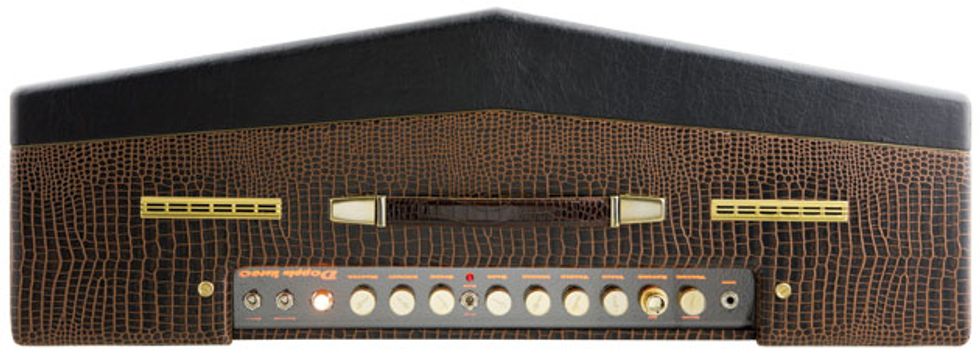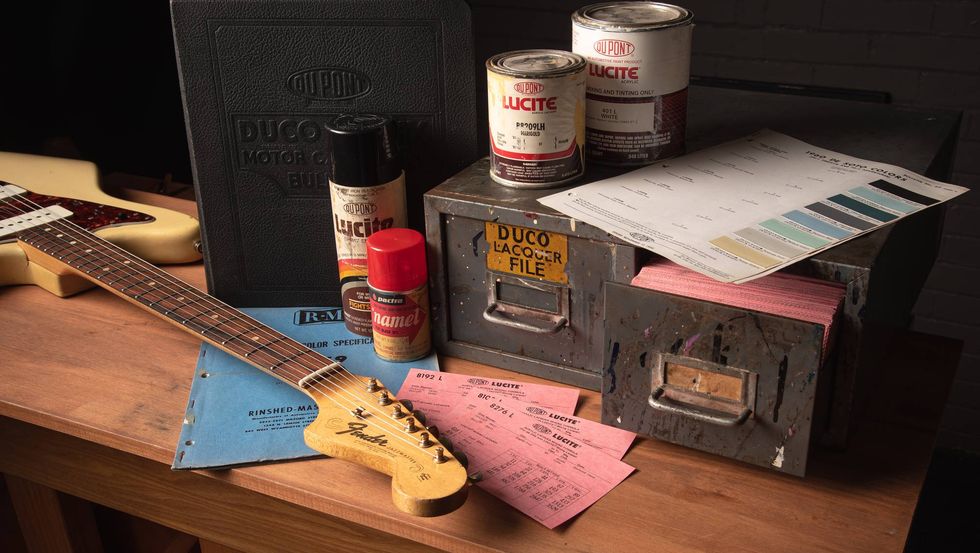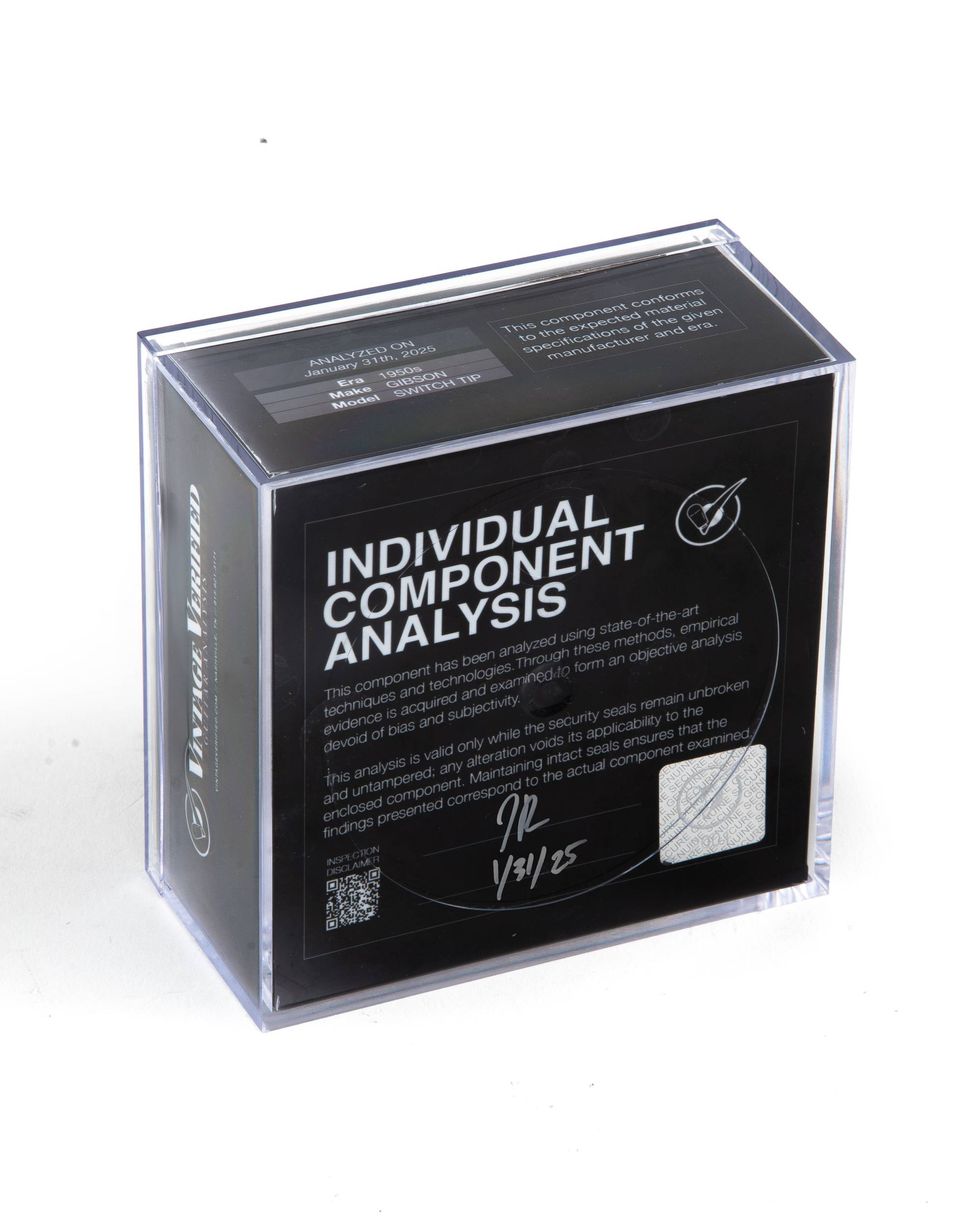Gear reviewers tend to describe new amps in terms of old ones. We rely on stock phrases: “Vox-like chime,” “Blackface-style scoop,” “Marshall-like midrange.” That usually works out fine, because new amps also tend to rely on what’s come before. But comparisons aren’t so easy when confronted with an amp as unique, idiosyncratic, and just plain weird as Siegmund’s massive Doppler combo. I’ve never encountered anything like it, and I bet you haven’t either.
Big and Blingy
The Doppler is an imposing beast, weighing in at 70 pounds—think silverface Fender Twin with JBLs, only more so. Like those Twins, it comes with detachable casters—five of them to suit the amp’s trapezoidal shape. The amp is as wide as it is heavy, measuring an impressive 33.5" from left to right. The cabinet is solid pine. The components are mostly high-end NOS stuff, including most of the tubes, and the circuit is immaculately hand-wired on terminal strip. The transformers are from Mercury Magnetics, with the output transformer a custom model and one tube rectifier.
On the outside, bling abounds. Our review model was decked out in faux-alligator Tolex and black leather with gold-plated knobs, vents, screws, and handle hardware. The control panel glows with golden light when you power up. This amp will get you noticed.
Styled for Stereo
Doppler’s marquee feature is its stereo sound, but it’s not the sort of stereo effect you encounter on, say, vintage and modern Magnatones. Most amps with stereo trem/vibrato send a modulated version of your signal to one speaker while the dry signal (or an inverted version of the modulated signal) feeds the other speaker, producing a spacious stereo effect.
But here—through a trademarked process called Asymmetric Frequency Soundstage—the signal encounters a crossover circuit that routes lows to the left speaker and highs to the right. Contrasting speakers emphasize the effect: a massive 15" Weber 15A200 for the bass, and a 10" Tone Tubby Silver Bullet for the right. The power tubes for each side also differ, with a single KT66 for the low-end left side and an EL34 for the brighter right. Each side employs two 6SL7s—relatively rare octal preamp tubes that appeared in some early-’60s amps. (They’re admired for their ultra-present, non-compressed sound, and feared for their noisy, microphonic tendencies.)

Wild, Wild Wobble
Given Doppler’s unconventional architecture, it’s no surprise that the amp produces unusual vibrato effects. While the dual-frequency arrangement seems inspired by vintage Leslie cabinets, the resulting effect doesn’t sound Leslie-like, or even especially “dopplery.” The modulation is asymmetrical, closer to a Uni-Vibe’s lopsided wobble than the evenly spaced pulses of traditional amp trem. But the tone isn’t very Uni-Vibe-like either. Because separate frequencies are routed to left and right, you don’t get the phasy quality you encounter when identical or overlapping frequency ranges are pitted against each other.
So what does Doppler’s modulation sound like? It’s an offbeat trem/vibrato effect with strong, sometimes jerky rhythms and deep modulation even at modest intensity settings. This striking effect wouldn’t sound out of place on one of Radiohead’s classic albums. The vibrato section has independent rate and depth controls, plus a fast/slow toggle and a rate-indicator LED. You can also connect the included controller pedal via stereo cord to set the rate by foot and switch the vibrato effect on and off. (I recorded the example clips with a matched pair of AKG 414 condenser mics, panning the two signals fully left and right.)
Ratings
Pros:
Unique sound. Quality materials. Nice build.
Cons:
Limited headroom. Harsh distortion. No traditional trem/vibrato sound. Expensive.
Tones:
Ease of Use:
Build/Design:
Value:
Street:
$3,995
Siegmund Doppler Stereo Combo
siegmundguitars.com
Unexpected Behavior
Given its bulk, Doppler doesn’t seem terribly loud. There’s a master volume control, but driving the input while lowering the master tends to yield hard, harsh sounds. When you whack the input harder, the resulting tone is likelier to bark than purr. The amp is also rather noisy. There’s not a lot of clean headroom—I sometimes found myself overdriving the input in an unpleasant way, even when using guitars with vintage-output pickups. Whether it’s the low-compression preamp tubes or some other aspect of the amp’s design, Doppler simply doesn’t smooth out as levels are raised. Then again, the focus here is relatively clean tones that best showcase the modulation effects.
There are nice-sounding treble, mid, and bass controls, plus an additional voice knob that prunes lows and low mids. The latter is helpful for balancing the two sides, dialing back the boomy, low-mid resonance that can accumulate on the dark channel. Still, miking the amp can be tricky: There aren’t separate volume controls per side, and the bright side is usually far hotter than the bass side. (Of course, you can balance the level as desired in a DAW or at the mixing board.)
I encountered odd behavior from the effect-section controls. While a pair of concentric knobs serves well to set the reverb length and mix, the reverb effect comes on very strong, very soon—even 10% up is quite wet. At high settings, the reverb spirals into self-oscillation. Trem depth settings about 12 o’clock produce a percussive pop with each modulation cycle, rendering higher-intensity settings hard to use. And given Doppler’s focus on modulation sounds, I can’t help wishing there was more control over the modulating waveform.
The Verdict
Doppler is different. Its unique tones range from striking to strident. It generates unconventional trem/vibrato sounds, though you could probably create similar effects with two amps and a couple of stompboxes. I’d be thrilled to employ these offbeat modulation sounds on a recording, but probably not thrilled enough to make this big amp a constant companion, especially given its modest versatility and far-from-modest price.









![Rig Rundown: John 5 [2026]](https://www.premierguitar.com/media-library/youtube.jpg?id=62681883&width=1245&height=700&quality=70&coordinates=0%2C45%2C0%2C45)









![Rig Rundown: Russian Circles’ Mike Sullivan [2025]](https://www.premierguitar.com/media-library/youtube.jpg?id=62303631&width=1245&height=700&quality=70&coordinates=0%2C0%2C0%2C0)







